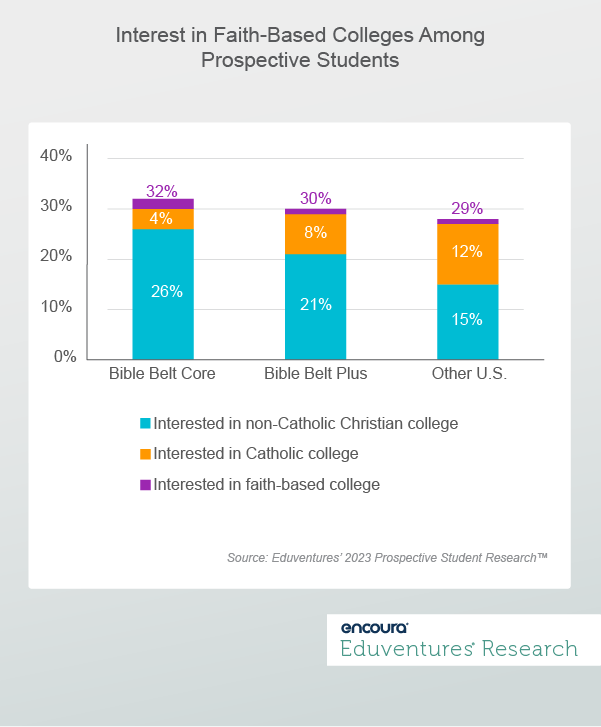According to Higher Ed Dive, more than 40% of the institutions that closed or consolidated since the start of the pandemic were Christian colleges. Considering that these institutions make up 24% of all two- and four-year higher education institutions in the United States, the disproportionate closure rate is concerning.
But the enrollment declines driving the closures are not distributed evenly. Some Christian colleges thrive, while others struggle to attract students. What does the market look like for students who are interested in Christian colleges, and what are some of these schools doing right?
Regional Variations in Faith-Based College Preferences
Religious identity in the United States varies by region, with the population of the Bible Belt most strongly identifying as non-Catholic Christians. It would then be reasonable to assume that interest in a faith-based college is also strongest in the Bible Belt, but which states make up the Bible Belt is widely debated.
Nine states consistently appear on these lists, including Alabama, Arkansas, Georgia, Louisiana, Mississippi, North Carolina, South Carolina, Oklahoma, and Tennessee. For this analysis, we will consider them the “core” Bible Belt states. Others are also thought to be fully or partially part of the Bible Belt, including Florida, Kansas, Kentucky, Missouri, Texas, Virginia, and West Virginia. We will call these states “Bible Belt Plus.“
Figure 1 shows that while interest in explicitly non-Catholic Christian colleges is higher in Bible Belt states, overall rates of student interest in a faith-based college more generally is comparable to the rest of the United States.

Overall, just under a third of college-bound high school students are interested in attending a faith-based institution. A subset of these students is looking for a Christian college, with numbers dropping substantially outside the Bible Belt.
For institutions that rely on students who are looking for a specific denomination (not featured in Figure 1), the prospect pool gets even smaller. In Bible Belt Core and Bible Belt Plus states, the most desired sought after denomination of a future college is Baptist (10% Core and 4% Plus). In the rest of the U.S., non-denominational colleges are the most popular choice of students who are interested in Christian institutions (4%).
While many small Christian colleges are struggling for enrollments, others can be quite selective. In fact, the total full-time, first-time undergraduate enrollment market share of Christian institutions has grown from 5% in 2011 to 9% in 2021. Further, the total number of students enrolled at Christian colleges nearly doubled within this timeframe.
Despite a relatively low appetite for Christian education, students are still drawn to these schools—at least to some of them. What is the difference between these selective and the less selective institutions?
Your Mission vs. Their Mission
Figure 2 shows how prospective students describe selective and less selective Christian colleges. The size of each word is relative to the number of students who submitted this description.

Remarkably, while both word clouds describe Christian-affiliated institutions, only two of the more prominent descriptions overlap: “welcoming” and “friendly.” More selective Christian institutions are more often perceived as “prestigious,” “rigorous,” “innovative,” and “academic.” Notably, no words are used to describe the school’s mission or even affiliation. Less selective Christian institutions, on the other hand, are more frequently described as “Christian,” “religious,” and “community,” with few descriptions of academics.
Another interesting difference: among all prospects who had inquired at a less selective Christian institution, 62% said they were interested in a faith-based college compared to 29% of inquiries at the selective Christian colleges. This accounts for some of the differences in perception.
The inquiry and applicant pools, and yield, at the less selective Christian schools are also significantly smaller than those at the selective institutions. This suggests that selective institutions are successful in attracting a broader market, not just a core market of Christian students looking for Christian colleges.
The question is, how are these selective Christian schools—those with missions that are similar to less selective institutions—able to attract so many more students, especially so many who are not specifically looking for a faith-based education?
These institutions understand that they are not only competing for students among themselves but also with public institutions. Therefore, to be competitive in a shrinking student market, selective Christian colleges appeal to broader student priorities.
For example, most college-bound students are looking for academic strength (58%), affordability (52%), and career preparation (46%) when evaluating colleges. A minority of students will look for these things within the context of a Christian environment; many more will consider a Christian environment if they believe the school will meet these priorities.
The Bottom Line
No doubt, mission matters. The market for students interested solely in a Christian education, however, is small. Many schools have recognized this and have built strong brands that attract a broader range of students. To be competitive in new markets in the face of shrinking college demand, Christian institutions must lead by addressing core prospect concerns: academics, career, and cost.
That does not mean they need to abandon their missions in the recruitment conversation. Rather, they can put student priorities within the context of the Christian mission. This can be done by highlighting strong academics that tie into the mission or demonstrating alumni career outcomes that align with Christian values. While the tone can be mission-centered, the story should always revolve around the main character: the student.

